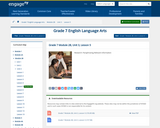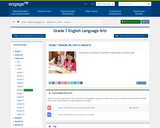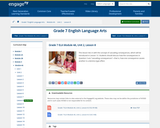
In this lesson, students work with Steps 3 and 4 of the Researcher’s Roadmap.
- Subject:
- English Language Arts
- Material Type:
- Lesson Plan
- Provider:
- EngageNY
- Author:
- Expeditionary Learning
- Date Added:
- 04/04/2014

In this lesson, students work with Steps 3 and 4 of the Researcher’s Roadmap.

This lesson includes the Mid-Unit 3 Assessment and Independent Reading Check.

In this lesson, students work with Step 5 on the Researcher’s Roadmap.

In this lesson, students write several paragraphs that synthesize their learning and demonstrate what they have learned about working conditions.

In this lesson, students begin their research project.

In this lesson, students work with Steps 3 and 4 of the researcher’s roadmap.

In this lesson, students complete the Mid-Unit 3 Assessment.

In this lesson, students choose the ads they will analyze in their performance task.

In this lesson, students have arrived at Step 6 on the researcher’s roadmap. For the End of Unit 3 Assessment, they write several paragraphs that synthesize their learning and demonstrate what they have learned about advertising.

This is students’ second day of conducting independent Internet research. In this lesson, they continue working to research supporting questions.

This is the first lesson in a full unit that scaffolds background knowledge, research skills, and note-taking toward a final written argument in which students will present a position on whether the American Academy of Pediatrics should increase its recent recommendation for screen time for children from two hours to four hours.

This lesson offers a quick review of the skill of paraphrasing, which is taught in Module 2. Students who have not done Module 2 will have plenty of review to catch up. This lesson also continues the launch of the researcher’s notebook.

This lesson ties in with the concept of cascading consequences, which will be introduced in Lesson 13. Students should discuss how the consequences in Question 3 are “cascading consequences”—that is, how one consequence causes another in a domino-type effect.

In this lesson, students conduct an independent reading check-in as a means of seeing how the independent reading is going midway through the unit. In this lesson, students begin working to research supporting questions.

This is the last lesson students are given time to revise their position papers in class. Students should be encouraged to ask any lingering questions about their essays, even if they do not pertain to today’s focus on coherence, style, and vocabulary.

In this CCSS lesson, students will explore this story through text dependent questions, academic vocabulary, and writing assignments.

Students use a web-based activity to help them think critically about how to determine the quality of web resources. The students will understand the importance of authenticating online resources, recognize how the source of information may affect the quality of information found on a website, and use a template to authenticate and assess the quality of web sources.

This lesson will use the "infinite variety" of resources on the Internet to let students find their own image of Othello. The lesson will take them on a WebQuest, first to textual references, and then to on-line searches for images of Othello in film, play productions, and art. Then, students will write an essay about the casting of Othello to conclude the lesson.

In this lesson, students will use technology to gather information about famous authors to contribute to a PowerPoint presentation.

Through multiple lessons, students will explore career choices, set educational goals, and create a media project in which they share information about their chosen career.